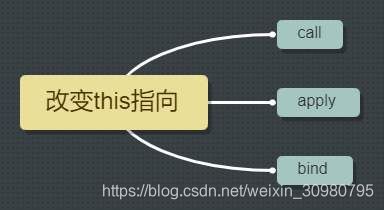JS中的this详解
一、this原理
this是JavaScript的一个关键字,函数调用时才会出现;
因为函数是在一定的环境中运行的,调用函数时肯定需要知道是[谁调用的]?就用到了this进行指向;
那么this到底指向的是什么?
this 既不指向函数自身,也不指函数的词法作用域,而是调用函数时的对象!
二、使用场景
(一)普通函数的调用,this指向的是Window
var name = '卡卡';
function cat(){
var name = '有鱼';
console.log(this.name);//卡卡
console.log(this);//Window {frames: Window, postMessage: ƒ, blur: ƒ, focus: ƒ, close: ƒ, …}
}
cat();
这里大家可能有疑问,不是说this指向的是调用函数的对象吗?cat()并没有对象出现啊,这个是因为在全局作用域中,window是根目录,一般可以省略,例如:alert()其实是 window.alert();
(二)对象的方法,this指的是该对象
1、一层作用域链时,this指的该对象
var name = '卡卡';
var cat = {
name:'有鱼',
eat:function(){
console.log(this.name);//有鱼
}
}
cat.eat();
因为函数eat是由cat对象调用的,所以this指向的是cat本身,所以cat.name=有鱼;
2、多层作用域链时,this指的是距离方法最近的一层对象
var name = '卡卡';
var cat = {
name:'有鱼',
eat1:{
name:'年年',
eat2:function(){
console.log(this.name);//年年
}
}
}
cat.eat1.eat2();
eat2方法包含在两个对象cat、eat1中,但是紧挨着的eat1对象,所以this.name指的是eat1的属性name,即[年年]
这里需要注意一个情况,如果cat.eat1.eat2这个结果赋值给一个变量eat3,则eat3()的值是多少呢?
var eat3 = cat.eat1.eat2;
eat3(); // 卡卡
答案是[卡卡],这个是因为经过赋值操作时,并未发起函数调用,eat3()这个才是真正的调用,而发起这个调用的是根对象window,所以this指的就是window,this.name=卡卡
(三)构造函数的调用,this指的是实例化的新对象
var name = '卡卡';
function Cat(){
this.name = '有鱼';
this.type = '英短蓝猫';
}
var cat1 = new Cat();
console.log(cat1);// 实例化新对象 Cat {name: "有鱼", type: "英短蓝猫"}
console.log(cat1.name);// 有鱼
(四)apply和call调用时,this指向参数中的对象
var name = '有鱼';
function eat(){
console.log(this.name);
}
var cat = {
name:'年年',
}
var dog = {
name:'高飞',
}
eat.call(cat);// 年年
eat.call(dog);// 高飞
apply方法和call方法相当于改变了显式的修改了prototype原型

(五)匿名函数调用,指向的是全局对象
var name = '卡卡';
var cat = {
name:'有鱼',
eat:(function(){
console.log(this.name);//卡卡
})()
}
cat.eat;
这里提一下匿名函数调用方式,常用的有三种方法:
//①先用()包起来,然后再后面跟 (参数)
(function(data){
console.log(data);
})("222");
//②先后面跟(参数),然后再()包起来
(function(data){
console.log(data);
}("333"));
//③正常函数格式,前面加 !
!function(data){
console.log(data);
}("444");
(六)定时器中调用,指向的是全局变量
常用的定时器有setInterval和setTimeout,拿setInterval举例子:
var name = '卡卡';
var cat = setInterval(function(){
var name = '有鱼';
console.log(this.name);// 卡卡
clearInterval(cat);
},500);
其实定时器的本质,也是一种匿名函数的形式。
(七)箭头函数调用
如果箭头函数被非箭头函数包含,则this绑定的是最近一层非箭头函数的this,否则this的值则被设置为全局对象
var name = 'window';
var student = {
name: '若川',
doSth: function(){
// var self = this;
var arrowDoSth = () => {
// console.log(self.name);
console.log(this.name);
}
arrowDoSth();
},
arrowDoSth2: () => {
console.log(this.name);
}
}
student.doSth(); // '若川'
student.arrowDoSth2(); // 'window'
(八)DOM事件处理函数调用
<button class="button">onclick</button>
<ul class="list">
<li>1</li>
<li>2</li>
<li>3</li>
</ul>
<script>
var button = document.querySelector('button');
button.onclick = function(ev){
console.log(this);
console.log(this === ev.currentTarget); // true
}
var list = document.querySelector('.list');
list.addEventListener('click', function(ev){
console.log(this === list); // true
console.log(this === ev.currentTarget); // true
console.log(this);
console.log(ev.target);
}, false);
</script>
onclick和addEventerListener是指向绑定事件的元素。
一些浏览器,比如IE6~IE8下使用attachEvent,this指向是window。
顺便提下:面试官也经常考察ev.currentTarget和ev.target的区别。
ev.currentTarget是绑定事件的元素,而ev.target是当前触发事件的元素。比如这里的分别是ul和li。
但也可能点击的是ul,这时ev.currentTarget和ev.target就相等了。
总结:
①普通函数的调用,this指向的是window
②对象方法的调用,this指的是该对象,且是最近的对象
③构造函数的调用,this指的是实例化的新对象
④apply和call调用,this指向参数中的对象
⑤匿名函数的调用,this指向的是全局对象window
⑥定时器中的调用,this指向的是全局变量window
7.箭头函数被非箭头函数包含,则this绑定的是最近一层非箭头函数的this,否则this的值则被设置为全局对象
8.onclick和addEventerListener是指向绑定事件的元素(ev.currentTarget)